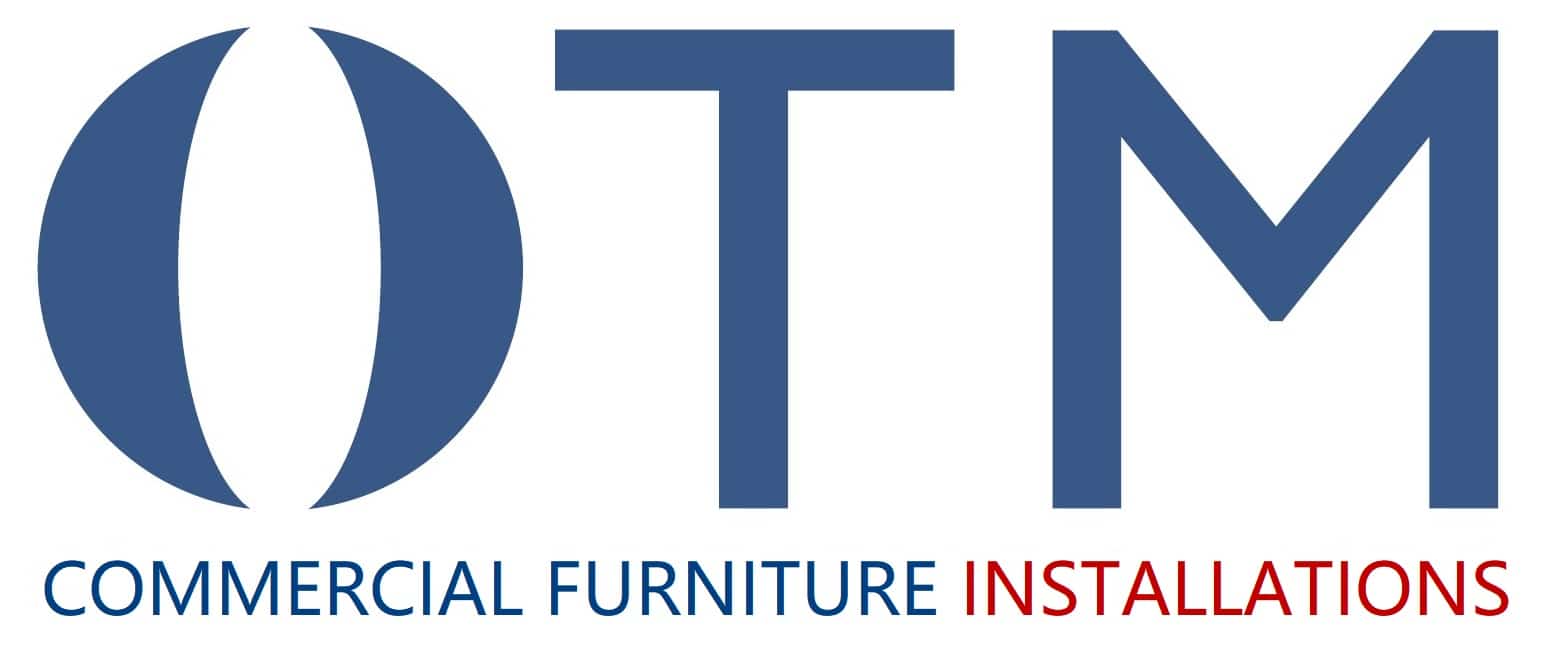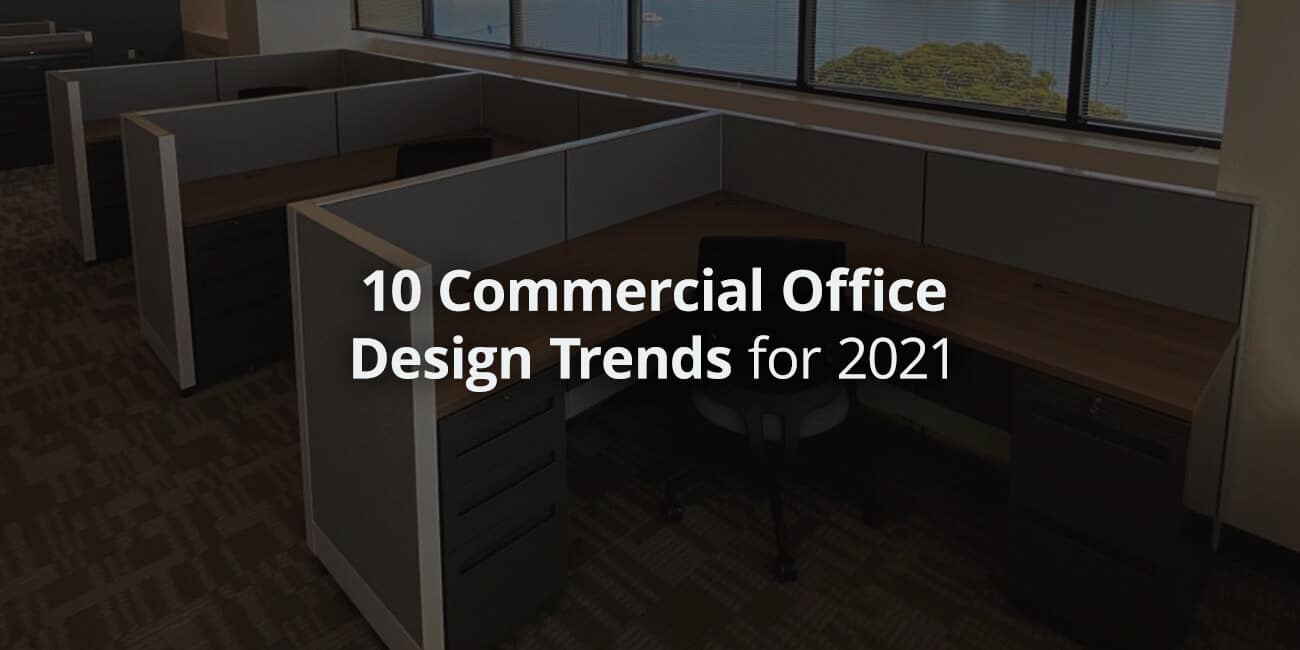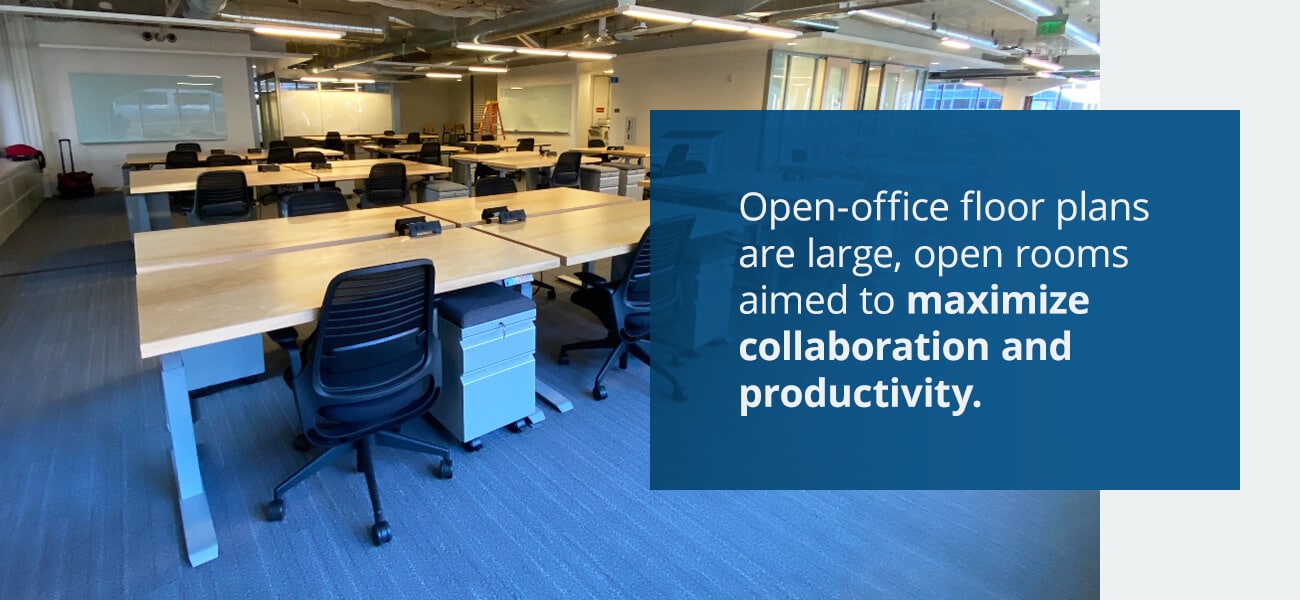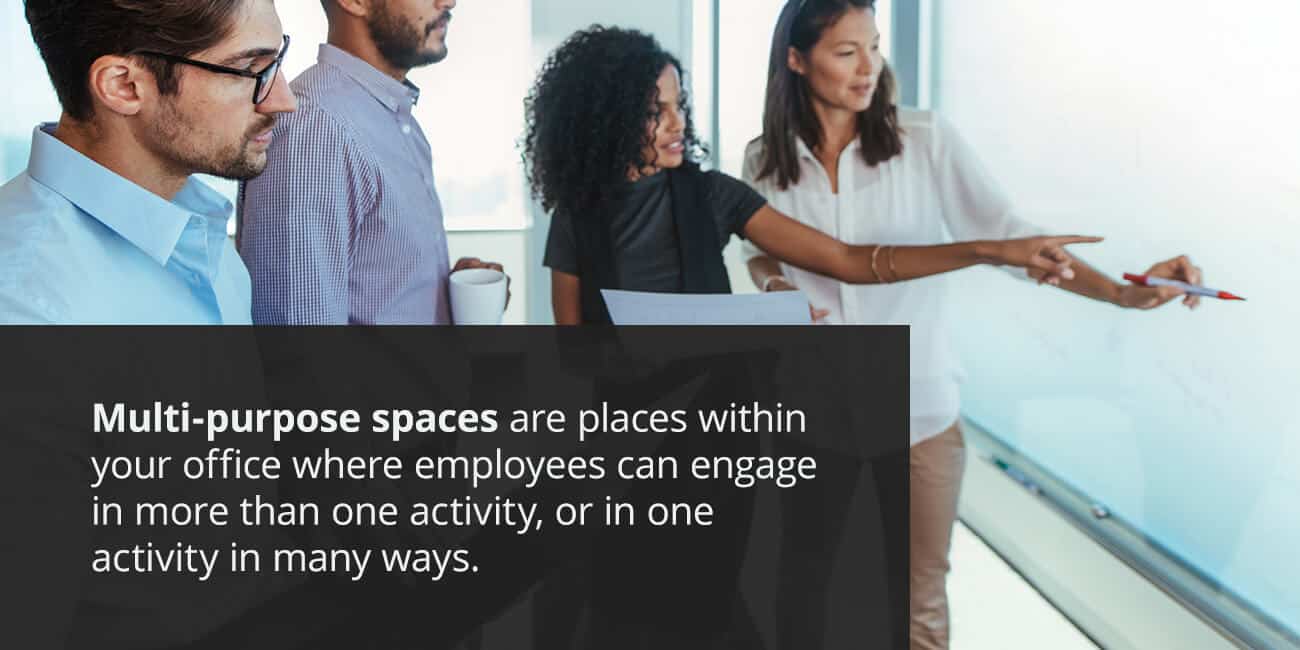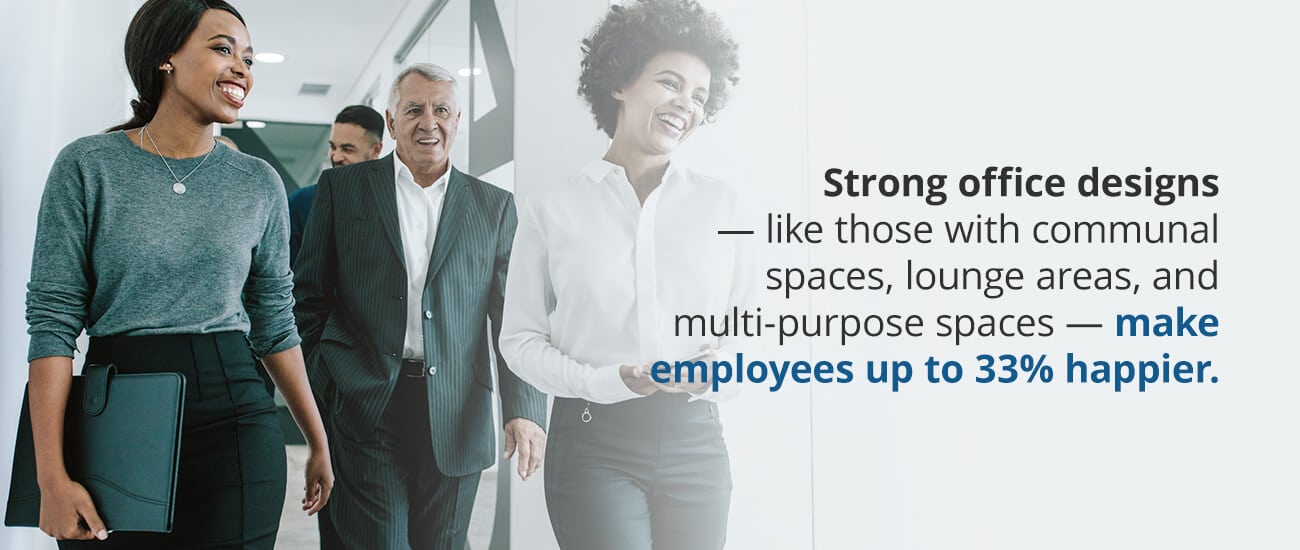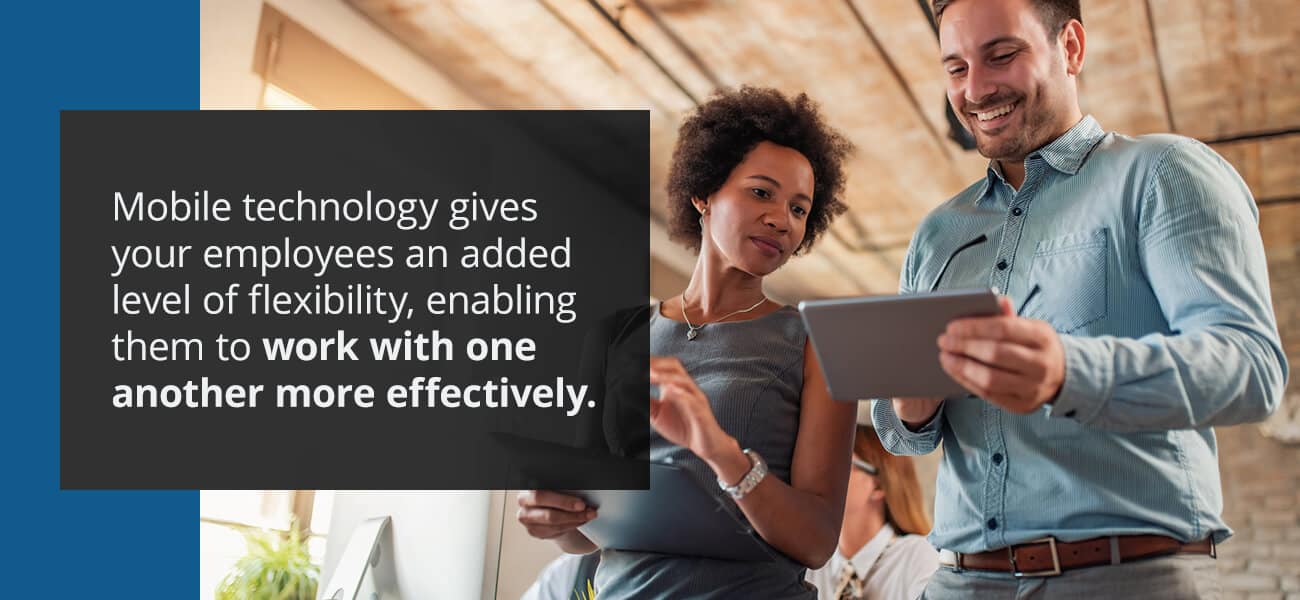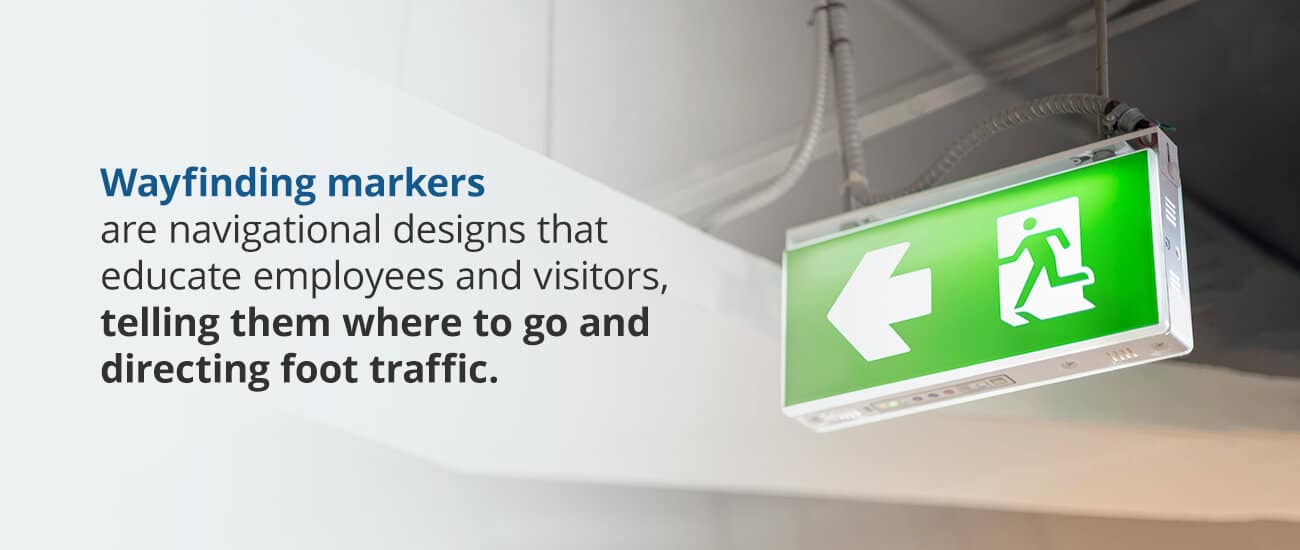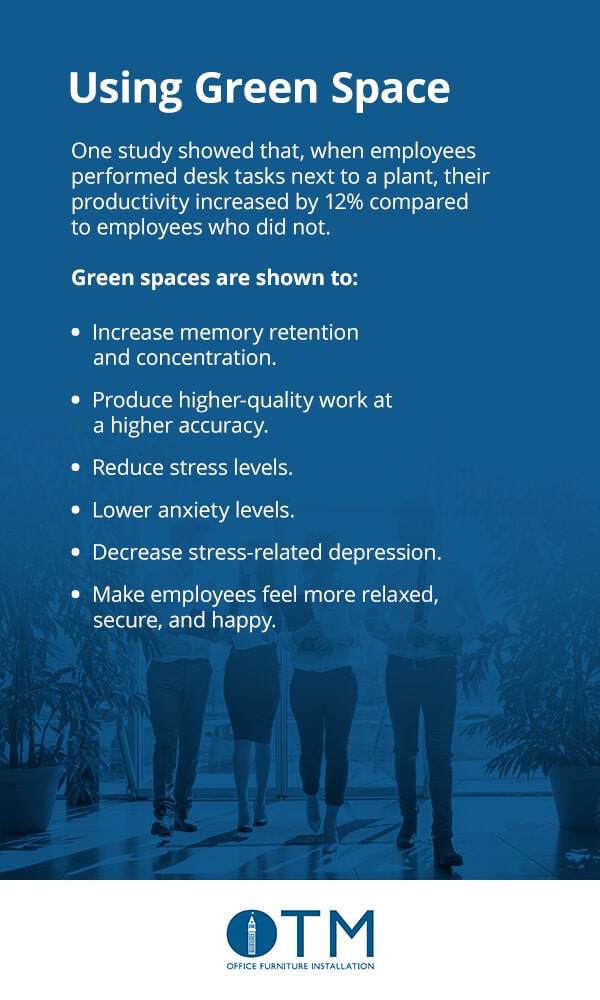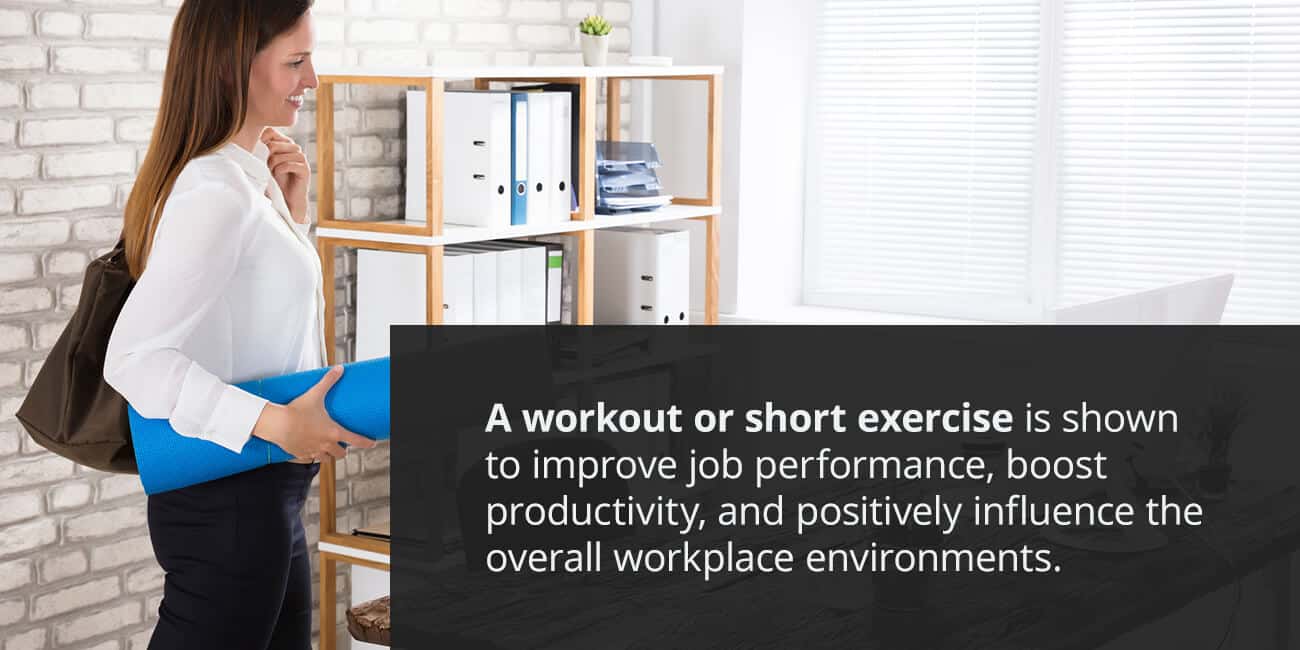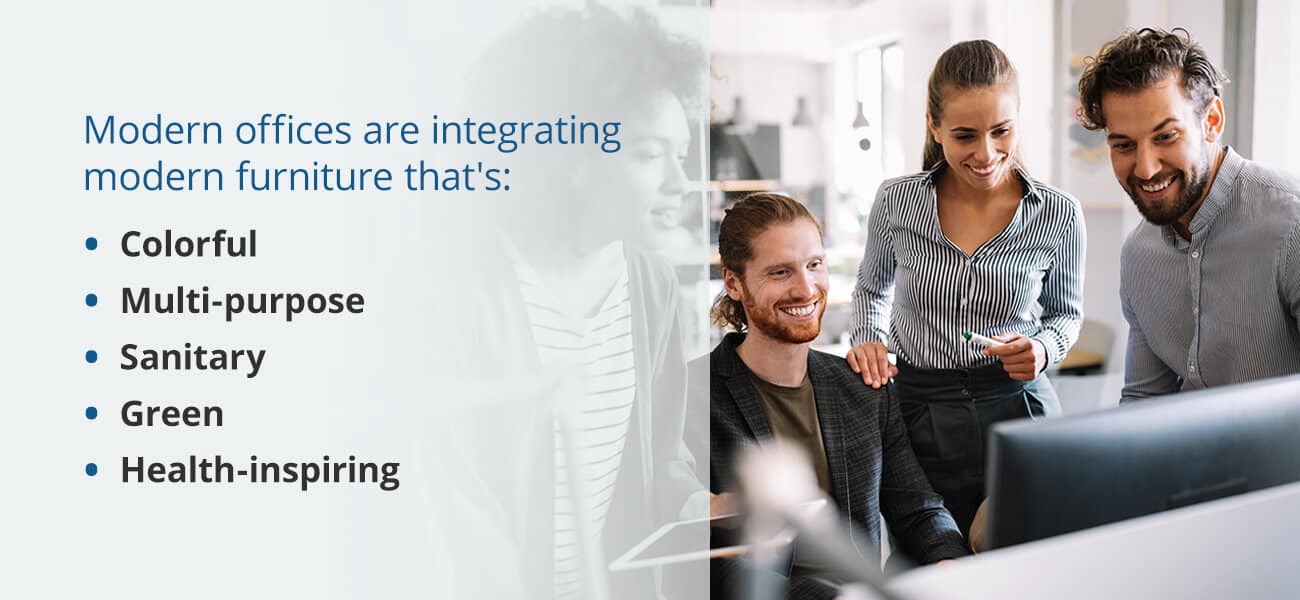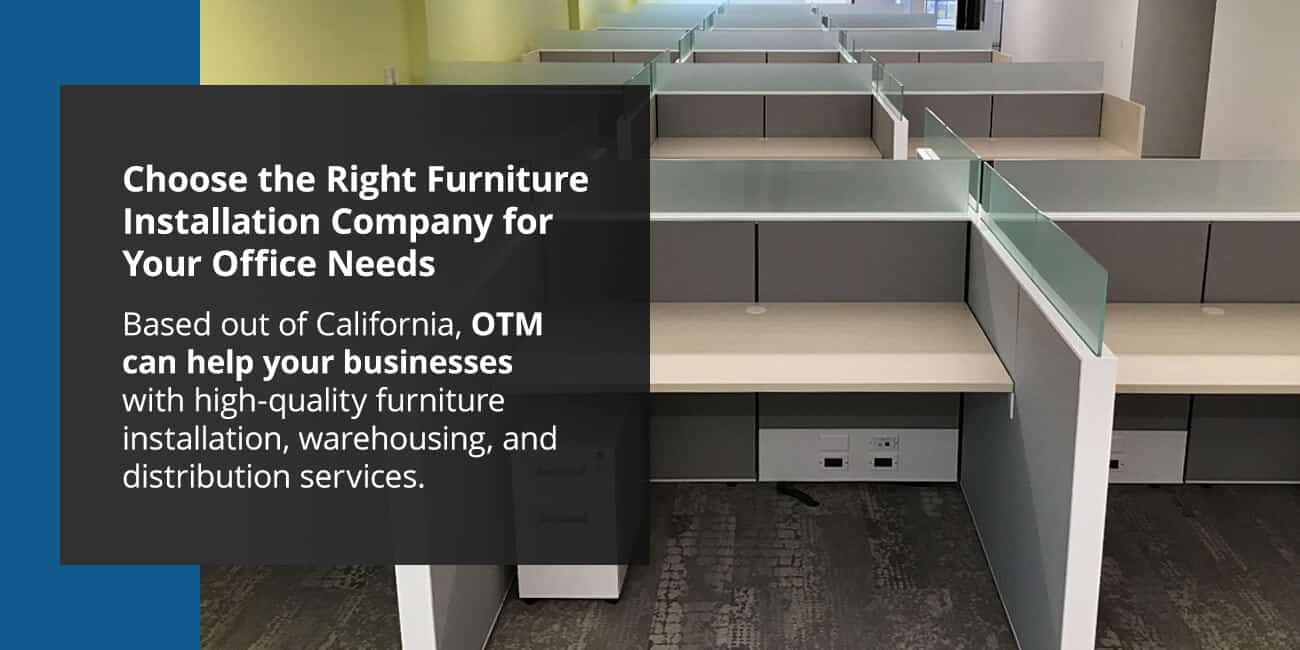Office managers are consistently looking for ways to improve their office design. A good office design encourages team collaboration, improves productivity, and increases sales. Some ways you can improve your office design are through multi-purpose workspaces, the strategic use of color, and mood-boosting green spaces.
Here, you’ll learn more about these office interior design ideas, as well as 10 modern trends you can use as inspiration for your office remodel.
What Makes a Good Office Design?
A good office design strategizes traffic flow, group workspaces, individual workspaces, recharge spaces, and other design aspects — aimed to lower stress, increase employee productivity, and retain employees.
Before designing your office, take a few days to consider your current office’s natural rhythm. Notice what works well and what needs improvement.
For example, suppose you notice that your employees spend time wandering the hallways or interrupting other employees in their workspaces to chat. In that case, your office may need a communal area for recharging. Or, if you notice your office relies heavily on collaboration, you may benefit from a multi-purpose workspace to accommodate this high collaboration rate.
As you read our list of 10 commercial office interior design trends, consider your office’s unique needs and how they may improve daily operations for a better office design.
What Should Every Office Have?
Of course, every office should have the basic necessities, like chairs, tables, and meeting rooms. Other things offices should have are:
- Fitness furniture: Offices are going to see a cultural shift to health and fitness initiatives. Incorporate fitness furniture into your everyday office design, which is discussed later in this post.
- Greenery: Greenery brings the benefits of nature into the workplace. Add green aspects into your office by placing plants at each collaborative desk or creating an outdoor seating area.
- Collaborative spaces: Many businesses rely on collaboration. Create a comfortable space within your office for daily collaboration, and make the workplace flexible to meet changing needs.
- Flexible workspaces: Flexible workspaces are adjustable to meet each team or employee’s needs. Examples include movable furniture, protective borders, and standing desks.
- Sanitation stations: 2020 brought many learning experiences, including those brought upon by the coronavirus pandemic. In 2021, offices are learning from these opportunities and making employees feel safe by building sanitation stations.
How Do You Design Your Corporate Office?
When designing your corporate office, consider these design ideas:
- Use the right furniture: Furniture provides functionality to your office. Collaborate with furniture suppliers and rely on a trusted company to install your furniture. Discuss collaborative furniture options, like standing desks or maneuverable conference tables.
- Strategize colors: Colors influence the way employees feel in the workspace. Choose the right colors that best represent your brand and the way you want your employees to feel. Add color to your walls, and in other furniture and decorative aspects, too.
- Decorate strategically: Decorations add personality to your workplace. Choose the right logos, symbols, art, greenery, and other decor to create a workplace where your employees feel comfortable and productive.
10 Commercial Office Design Ideas
Some ideas for modern office setups are:
1. Open Floor Plans
We’ve heard a lot of discussion about open floor plans in the past few years. Open-office floor plans are large, open rooms aimed to maximize collaboration and productivity. They eliminate most enclosed rooms, like cubicles, offices, or meeting rooms.
When designed strategically, open floor plans can be beneficial for many businesses. Benefit from open floor plans by increased:
- Communication: An open office eliminates physical barriers, allowing employees access to important information and group discussions. Teams work closely with one another, able to better communicate changes or progressions.
- Collaboration: Employees work within the same vicinity in an open office. One company, The Bridgespan Group, tested an open office floor plan for six months. Employees found it easy to collaborate with one another, reporting it easy to share ideas or bring people into meetings.
- Culture: Company culture is a powerful business tool. It creates trust, cooperation, and efficient decision-making, as well as a strong employee-business connection and a deeper understanding between coworkers. Through design, collaboration, and communication, businesses can create a stronger work culture within their business environment.
It’s important to consider that not every employee or business will benefit from open floor plans. Because of the benefits listed above, businesses that rely on high collaboration — such as visual arts, marketing, or service support businesses — will benefit most. Even within these businesses, employees will likely want an area to withdraw and recharge or speak with groups privately. For this reason, integrate open-office floor plans with other multi-purpose spaces.
2. Multi-Purpose Spaces
Multi-purpose spaces are places within your office where employees can engage in more than one activity, or in one activity in many ways. Essentially, it’s a simplified collection of many workspaces, like meeting rooms or independent workspaces.
Design a multi-purpose space by outfitting your office with:
- Rolling tables: Make sure your furniture is adaptable to employees’ goals. For example, if one day your employees are working in a large team, allow them to move tables into a long conference table. Or, if they’re working in small breakout groups, allow them to arrange the space accordingly.
- Moveable chairs: Along with rolling tables, provide employees with easily moveable chairs, like rolling chairs.
- Smartboards: Multi-purpose spaces encourage collaboration. Collaborating teams should have a space to take notes and project information. For this, consider installing smartboards in your office.
- Retractable dividers: Create a sense of privacy by installing retractable or easily adjustable dividers. That way, people can create a desk-away-from-desk scenario, easily transitioning from group work to independent deep work.
- Standing desks: Multi-purpose spaces are generally movement-oriented. Encourage a healthier lifestyle by providing standing desks, which employees can reserve. Consider adding exercise ball chairs in other areas within your office to further encouraging movement.
Multi-purpose spaces empower employees to take charge of their workplace routine, giving them permission to control where and how they work.
3. Communal Space and Lounge Areas
Businesses are always looking for ways to make their office environment more functional and inspire productivity. Like multi-purpose spaces, communal spaces and lounge areas give employees the freedom to choose where and how they work.
The overarching goal of a business owner is to make employees happier. Employees who are happy are, by default, less likely to feel stressed or anxious about their daily work life. They experience improved mental health and increased ability to work. Employees work faster and deeper — they make more work-related phone calls, work more quickly and more diligently, and boost sales.
Interestingly, employees rank pay low when evaluating what workplace activities make them happiest. They value other factors, like office designs. Strong office designs — like those with communal spaces, lounge areas, and multi-purpose spaces — make employees up to 33% happier. And, when workers are happy, studies show they are 13% more productive.
Design your communal spaces and lounge areas in the center of your workplace. Employees use communal spaces and lounge areas to move, discuss, and recharge during their workday. Supply them with comfortable seating, a strong Wi-Fi connection, and plenty of electrical outlets.
4. Remote Work and Sanitation Design
According to a 2020 study, 52% of people work from home full-time, 29% work in an office full-time, and 19% work in-office and at-home. This is a huge leap from the 20% of people that worked from home before the coronavirus outbreak. Now, after these drastic work environment changes, over half — 52% — of U.S. employees report their ideal working situation to be a hybrid of in-office and at-home.
Most people say they enjoy hybrid working situations because they:
- Have concerns about COVID-19.
- Feel more productive.
- Feel more comfortable.
- Avoid distractions.
- Have a better workspace arrangement.
- Still have access to workplace spaces, when needed.
Because of these impressions, remote work environments have a positive impact on:
- Creativity.
- Colleague relationships.
- Team management.
- Problem-solving.
- Productivity.
- Communication.
While it’s fair to say the coronavirus pandemic affected the average working environment, employees benefited by conforming to a more productive work environment. COVID-19 did, however, influence the way workers feel about office sanitation.
Integrate sanitation stations within your office design. Examples of sanitary measures you can take are placing hand sanitization stations at each desk, supplying cleaning equipment — like sanitation wipes and garbage bins — in communal areas, and placing dividers between independent work areas.
5. Harnessing New Mobile Technology
As offices become more mobile, technology is becoming more mobile, too. Mobile tech like laptops and tablets allow employees to navigate around the office seamlessly.
Open offices, multi-purposed spaces, communal areas, and remote work require flexible technology. Employees are navigating the workplace, and as they collaborate with peers and engage in spontaneous deep work, they require easy access to their information. Mobile technology gives your employees an added level of flexibility, enabling them to work with one another more effectively.
Already, 89% of organizations let workers take their devices to work with a bring-your-own-device (BYOD) policy. These organizations are seeing a higher productivity rate, almost 37 minutes per week. And, high productivity rates generate higher sales — around $350 every year per employee.
Consider investing in mobile technology for your office. When implemented strategically, your technological investment will pay for itself with increased employee productivity.
6. Wayfinding Markers
All offices, whether your office has a complex layout or not, require wayfinding markers. Wayfinding markers are navigational designs that educate employees and visitors, telling them where to go and directing foot traffic.
Examples of useful wayfinding markers to include in your office are:
- Maps
- Directories
- Entrances and emergency exits
- Bathroom symbols
- Stairway or elevator symbols
Think about symbols, logos, and branding colors when designing wayfinding markers. These factors create consistency, making markers easy to understand. Symbols — like female or male, directional arrows, and staircase symbols — break up texts, while logos and colors create a consistent brand image that your employees and visitors will appreciate.
Place wayfinding markers at eye level where traffic is heavy so people can easily see them. Talk with your commercial office building’s supervisor to learn more about your options, like placing your name or logo on the lobby directory.
7. Using the Power of Color
The strategic use of color is shown to influence the way employees function in the office. Color psychology — the study of the way a person’s perception of color affects their moods — can help you choose the right color for your office to better portray your brand identity and boost employee mood, productivity, and collaboration.
The different colors and their attributed emotions are as follows:
- Red: A primary color, red is a powerful color portraying energy, strength, power, passion, and determination.
- Green: The color green connects people to nature. It represents purity, health, freshness, growth, and productivity.
- Blue: Another primary color, blue evokes feelings of serenity, tranquility, enthusiasm, compassion, and communication. It also has positive bodily reactions, like lowering heart rates and slowing metabolism.
- Brown: A tricky color to use within the office is brown. Brown is associated with feelings of seriousness, stability, and wisdom. Most people find this color secure and stable.
- Orange: Orange combines the powerful emotions of yellow and red, evoking feelings of optimism, cheerfulness, communication, and positivity.
- Yellow: The brightest color on the spectrum, yellow brings fresh ideas, creative projects, and new business initiatives. Studies also suggest that yellow enhances mental activity, heightens awareness, and boosts energy levels.
- Pink: Pink is a gentler alternative to red. It evokes feelings of tenderness, vulnerability, optimism, hope, and youth.
- Purple: A mixture of red and blue, purple is long associated with luxury and power. It also radiates nobility, ambition, creativity, and wisdom.
- White: On one end of the color spectrum, white symbolizes purity, wholeness, and innocence. It gives the perception of starting new, clearing cluttered minds and empowering creativity.
- Black: On the opposite end of the color spectrum, black is a double-edged sword — it can evoke feelings of elegance and mystery, or it can be depressing.
Some of the most beneficial colors to use in your office are blue, yellow, white, orange, and green. Colors you can use sparingly are purple, brown, and red. Designers generally avoid black in the workplace for its possible depressing effects.
8. Using Green Space
A trend that’s rising in modern workplaces, and is likely to continue rising as green initiatives become more innovative, are green spaces. Green spaces are areas within the office that embody nature. Studies suggest that green spaces offer long-term health benefits and improve employee retention.
Examples of green spaces in your office are plant-filled walls, outdoor seating areas with plenty of greenery, or decorating each office and collaboration space with plants, such as snake plants, English ivy, bamboo, Fiddle Leaf Figs, or Benjamin Figs. Even empowering employees to step outside for short moments throughout the day can improve memory retention by 20%.
One study showed that, when employees performed desk tasks next to a plant, their productivity increased by 12% compared to employees who did not. Additionally, employees reported they felt 10% more attentive, able to complete more tasks more efficiently. The study also suggests physical health benefits, like slowing elevated blood pressure.
Green spaces are shown to:
- Increase memory retention and concentration.
- Produce higher-quality work at a higher accuracy.
- Reduce stress levels.
- Lower anxiety levels.
- Decrease stress-related depression.
- Make employees feel more relaxed, secure, and happy.
When employees feel connected to nature, they also benefit socially, increasing their concern and empathy towards their peers. Green spaces also evoke increased feelings of responsibility, as people feel a sense of responsibility for caring for the environment.
9. Encouraging Health and Fitness
Most doctors encourage people to practice health and fitness routines outside of work. Now, businesses are bringing the positive effects of health and fitness into the office, seeing results such as fewer sick days, improved mood, and sharper thinking.
Employees benefit from 30-60 minute workouts as well as smaller healthy habits, like:
- Doing leg lifts at the desk.
- Parking farther in the parking lot.
- Standing and walking more throughout the day.
- Using restrooms farther away from their desk.
- Walking around the building during breaks.
- Taking the stairs instead of the elevator.
A workout or short exercise is shown to improve job performance, boost productivity, and positively influence the overall workplace environments. Other benefits include:
- Reduced the risk of disease: Regular exercise strengthens your heart and improves blood circulation, in return lowering risks of high cholesterol, coronary artery disease, and heart attack.
- Lesser chance of missed work: When employees are at a lower risk of developing a disease, there is a parallel lower chance of missed work.
- Improved mental health and mood: Bodies release hormones when exercising that make people feel more relaxed, help manage stress, and reduce the risk of depression.
- Sharper thinking, learning, and judgment: Additionally, bodies release proteins and other chemicals that benefit brain structure and function.
The biggest office change you can make is building a health-oriented business culture. This includes outfitting your office with healthy alternatives, such as standing desks, exercise ball chairs, and walking paths. Employees may enjoy the option of working out before or after their shift, or during their lunch break. For this, consider building a gym — and investment that can pay for itself through long-term improved employee performance.
10. Integrating Modern Furniture
Overall, modern offices are integrating modern furniture that’s:
- Colorful: Colors have an impact on the way employees work. Aside from your office’s walls, strategize the use of colors into your office furniture, like chairs or desks.
- Multi-purpose: Employees are more productive when they feel in control of their work lives. Supply your employees with multi-purpose furniture that is easily moveable and adjustable for team-based discussion and individual deep work.
- Sanitary: The coronavirus pandemic influenced the way employees feel about sanitation. They feel more strongly about sanitation practices, valuing sanitation and hand washings stations for safety.
- Green: This can be through decorative elements like plant walls or other environmentally friendly features, such as wooden furniture.
- Health-inspiring: Health and fitness are playing a big role in the workplace. Supply your employees with healthy alternatives, like replacing some desks in your multi-purpose spaces with standing desks or giving employees the option to switch their chairs with exercise ball chairs.
Use these interior commercial office design ideas as inspiration when renovating your office this year. Consult your office standards and other professionals, like a reputable furniture installation company, to make renovating your office easier.
Choose the Right Furniture Installation Company for Your Office Needs
Are you looking for a furniture installation company for your 2021 office remodel? OTM is an office furniture installation company that is ready to help you achieve your goals. Based out of California, OTM can help your businesses with high-quality furniture installation, warehousing, and distribution services.
We’d love to learn more about how we can help you. For more information, contact us online or call us at 717-609-1553.

